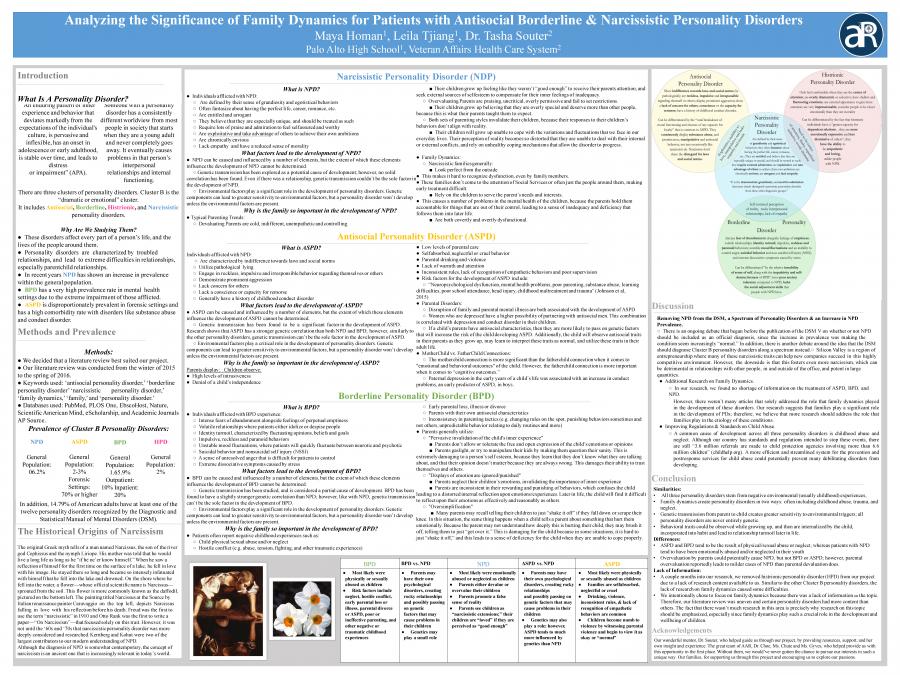Analysis of the Relationship Between Narcissistic Personality Disorders and Other Cluster B Personality Disorders by Maya H. & Leila T.
Presentation
Summary
What are the differences and similarities between Narcissistic Personality Disorder and the other Cluster B personality disorders (Antisocial, Borderline, and Histrionic) and how can we use those comparisons to better understand the clinical indications for those afflicted with personality disorders and those in the surrounding environment? Additionally, how can we use this information to increase our understanding of personality disorders as a whole? In our research, we have found that in general, personality disorders are not very well understood by the general public or even professionals. We would like to address this issue in our research by using more recent studies and literature to compare and contrast different Cluster B personality disorders. We hope that this process will give us a better understanding of personality disorders in general, as well as being able to distinguish the different Cluster B disorders. Specifically, we would like to focus on Narcissistic Personality Disorder (NPD), which contains aspects from many other Cluster B disorders; therefore, looking at all four personality disorders will allow us to better understand the clinical implications that are associated with NPD. Personality disorder are defined as “an enduring pattern of inner experience and behavior that deviates markedly from the expectations of the individual’s culture, is pervasive and inflexible, has an onset in adolescence or early adulthood, is stable over time, and leads to distress or impairment” (Dobbert 1). Additionally, PDs are sorted into three groups: “Cluster A, the odd/eccentric personality disorders, Cluster B, the dramatic/emotional personality disorders, and Cluster C, the anxious/fearful personality disorders” (Roark, 12). Narcissistic personality disorder is a Cluster B personality disorder, and is defined as “a pervasive pattern of grandiosity (in fantasy or behavior), need for admiration, and lack of empathy, beginning by early adulthood and present in a variety of contexts” (DSM-V, 669). Our society seems to promote narcissism and throw its general definition around; however, little is understood about the personality disorder that is becoming increasingly prevalent in our everyday lives. Some professionals refuse to even acknowledge that personality disorders are a genuine condition. However, there is a fine line between narcissism and having NPD, and it is something that needs to be addressed. Narcissism can be beneficial, even healthy, because to some degree, we all have a sense of narcissism. However, NPD blows this inner selfishness out of proportion, with devastating effects on family members, friends, coworkers, and the general population. It has been observed that “narcissistic personality disorder runs in families but this does not mean there is genetic transmission. Being raised as a child of a parent with NPD could lead to the development of NPD through early relational trauma” (Goldner-Vukov, Moore). Personality disorders don’t just affect the afflicted individual. They affect everyone in contact with that person, and draw others into their trap of dysfunction; therefore, it would be a mistake to not acknowledge the existence of personality disorders. Our study will be built solely on the prior work of others, by looking at the latest research on Cluster B personality disorders, and drawing our own conclusions and analysis from various texts. We hope that our study can bring a better understanding to the public about an issue that has devastating effects on mental health, and hopefully provide some answers to a growing number of people desperate to understand why people with personality disorders behave the way they do...

